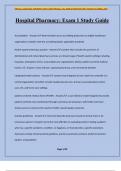EMILLECT 2024/2025 ACADEMIC YEAR ©2024 EMILLECT. ALL RIGHTS RESERVED FIRST PUBLISH OCTOBER, 2024
Hospital Pharmacy: Exam 1 Study Guide
Accreditation - Answer✔✔-determination by an accrediting body than an eligible healthcare
organization complies with the accrediting body's applicable standards
Health-system pharmacy practice - Answer✔✔-practice that includes the provision of
distributional and clinical pharmacy services at a broad range of health system settings including
hospitals, ambulatory clinics, accountable care organizations (ACOs), patient-centered medical
homes, LTC, hospice, home infusion, specialty pharmacy, and correctional facilities
integrated health systems - Answer✔✔-systems that integrate all care under the umbrella of a
central organization and often include inpatient/acute care, primary care/ambulatory clinics
care, LTC, and home care settings
patient centered medical home (PCMH) - Answer✔✔-a care delivery model designed to provide
patient-centered care coordinated through a primary care physician, with better and more
timely access to services that results in better overall quality outcomes
practice guidelines - Answer✔✔-tools that describe processes found by clinical trials or by
consensus opinion of experts to be the most effective in evaluating and/or treating a patient
who has a specific symptom, condition, or diagnosis, or that describe a specific procedure.
Synonyms include clinical practice guideline, practice parameter, protocol, preferred practice
pattern, and guideline
Page 1/19
,EMILLECT 2024/2025 ACADEMIC YEAR ©2024 EMILLECT. ALL RIGHTS RESERVED FIRST PUBLISH OCTOBER, 2024
practice model - Answer✔✔-the operational structure that defines how and where pharmacists
practice including the type of drug distribution system used, the layout and design of the
department, how pharmacists spend their time, practice infusions, and practice priorities. The
predominant practice models include the drug-distribution-centered model, the clinical-
pharmacist-centered model, the patient-centered integrated model, and the comprehensive
model
privileging - Answer✔✔-The process by which an oversight body of a health care organization or
other appropriate provider body, having reviewed an individual health care provider's
credentials and performance and found them satisfactory, authorizes that individual to perform
a specific scope of patient care services within that setting
regulation - Answer✔✔-governmental order having the force of law
What is a health-system pharmacy practice? - Answer✔✔-includes distributional and clinical
services and integrated health systems; there is a unified electronic medical record (EMR)
types of hospitals: - Answer✔✔-1. community hospital 2. specialized hospital 3. teaching
hospital 4. government hospital 5. multi-hospital system 6. for profit hospital- owned by
corporation, private investors 7. non-profit hospital- operated by religious, volunteer,
community groups
Medication use process: - Answer✔✔-1. prescribing- some pharmacists can prescribe some
medications (depends on where it is and what the medication is), pharmacy-to-dose, can have a
direct or indirect influence (privileging)
Page 2/19
, EMILLECT 2024/2025 ACADEMIC YEAR ©2024 EMILLECT. ALL RIGHTS RESERVED FIRST PUBLISH OCTOBER, 2024
2. transcribing- written order copied and manually or electronically entered into pharmacy or
medical record-> pharmacist must verify orders coming through the hospital (computerized
prescriber order entry used to eliminate some potential sources of error)
3. dispensing- transferring product after review and approval of the order to the area
responsible for administrating the medication
4. administration- giving the medication to the patient (usually done by nursing staff);
pharmacist clearly labels medication, using barcode systems
5. monitoring- monitoring the patient's response to the medication is a critical phase; reviewing
lab values; checking to see if the therapy chosen is effective
6. modifying and documenting- dosage changes, therapy discontinuations, new drug therapies,
etc.
Four different practice models: - Answer✔✔-1. drug-distribution centered: pharmacists
primarily distribute drugs and process new medication orders; rarely initiates major changes in
therapy (does not have a huge say in drug therapy chosen); not actively involved in the
healthcare team; has a reactive role
2. clinical-pharmacist centered: consists of the distribution pharmacist and clinical pharmacist;
there is a clinical pharmacist on the floors, working in a healthcare team, providing services,
helping physicians make decisions on the correct drug therapy; distribution pharmacist- manage
techs in dispensing and distributing meds (limited collaboration between the 2 types of
pharmacists)
Page 3/19




